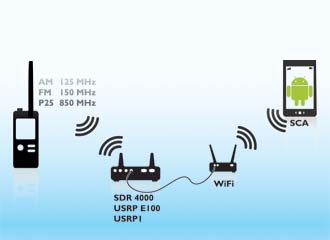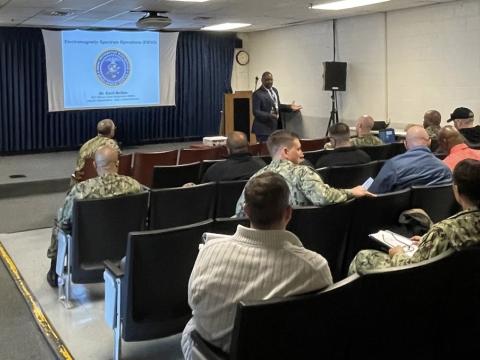Smartphones Become Smart Radios
 |
Researchers at the Communications Research Centre Canada have devised a method to run Joint Tactical Radio System Software Communications Architecture on smartphones. The result turns the devices into smart radios that support frequencies used by public safety organizations. (Image courtesy of Communications Research Centre Canada) |
Researchers at the Communications Research Centre Canada have proved the feasibility of running public-safety Joint Tactical Radio Network Software Communications Architecture on mobile devices. They successfully accessed three different first-responder frequencies with less modification and effort than expected. Since the initial demonstration, calls have come in from public and private organizations worldwide that are interested in the technology, while radio developers reassess their business plans in light of the new developments.
Before the center made its breakthrough, general opinion held that smartphones were too small and had the wrong power sources to run the software communications architecture (SCA) framework. And even if the SCA could operate on the platforms, the complex signal processing would fail. “One day we got tired of hearing it,” states Steve Bernier, research manager of advanced radio systems, Communications Research Centre (CRC) Canada. So developers decide to experiment and develop some metrics, maybe write a paper—until, Bernier explains, “To our surprise, everything came together a lot quicker than we ever dreamed.”
First the team tested an AM waveform on an Android operating system. The experiment consumed only 7 to 10 percent of central processing unit (CPU) cycles, so they moved on to testing FM waveforms, achieving the same result. At that point, researchers became more ambitious and tested accessing the Association of Public-Safety Communications Officials P25 waveform, a suite of standards for digital communications among public safety organizations in North America. Again, the test proved successful, though this time 50 to 60 percent of CPU cycles were consumed. In the efforts, researchers discovered that the AM/FM bands can operate on single-core phones while the P25 form requires a dual-core processor. Developers have tested one of each type from both Samsung and HTC.
Despite the progress, the smartphones still could not communicate with handheld devices running the frequencies because the phones support different bands. Developers worked around the problem by sending signals through an external radio frequency (RF) device that supports a wide range of frequencies. The CRC already had the necessary software running in other platforms, and although the team expected to make a lot of changes, it was able to establish the necessary communications without altering a single line of source code.
To create the interoperability, project personnel obtained the ORBexpress product from Objective Interface Systems, Incorporated. The technology is optimized for Android and provided the necessary Common Object Request Broker Architecture (CORBA) support; SCA-based radios use CORBA as the core communications framework. Developers also used POSIX—for Portable Operating System Interface—an application program interface, or API, standard that makes operating systems look alike from a programming standpoint. Bernier says as long as he and his team have access to the operating system and CORBA, they can use almost any hardware platform with the SCA software to make a software-defined radio (SDR). The architecture serves as an enabler to bring together all components to operate as a smart radio. Developers also employed the CRC’s latest SCA reference of implementation core framework, SCARI-GT, to enable running the Joint Tactical Radio System SCA public safety waveforms.
Each smartphone running the CRC applications is a standard device that has not been routed or modified. Assuming an RF connection, users simply press the app icon on their Android device for the desired waveform and then use their volume buttons as a push-to-talk control. The cellular carrier’s network does not come into play. In fact, during one demonstration, users received a call while they were running a smartphone as an SDR. Developers took the SIM card out of the devices after that because they only wanted to use them to prove their radio waveform concept.
Bernier explains that because the team implemented the waveforms in pure software, the prototypes bypass making use of the graphics processing unit (GPU), which would lower the load on the CPU. Researchers plan to experiment with that configuration. “But for us the demonstration was just to prove that you can get waveforms running on commercial handsets,” Bernier says. Because the center is a research institution, other groups can take advantage of its finding to advance the smartphone/smart radio concept. Those terms merge in the CRC’s experiments, because “smart” applies both to apps that can run on devices and the ability to adjust among different radio frequencies.
Because the current prototypes do not use the GPUs, developers who want to move the technology forward could make great advances without changing hardware. More possibilities open up with the cycle of smartphones advancing about every 18 months as manufacturers battle to create the latest and greatest. “The phone manufacturers are now in this war that PC manufacturers were in years back,” Bernier explains. They no longer sell their products based on call clarity, he says, but on what apps or software platforms support. As developers compete to put their products on the market, researchers working on the SCA capabilities can sit on the sideline and benefit from each new device released. Bernier explains that “we’re at the very beginning of a change project basically,” and over the next year to two years, more concrete examples of the technology will emerge.
The initial experiments marked an injection point into the SDR world, and developers of those radios and of the SCA no longer can deny that the technologies can operate via small devices, Bernier says, adding this will help eliminate one of the barriers to the widespread adoption of SDRs because the technology is applicable beyond expensive military platforms. Most people who license the technology do so for those “green boxes,” and Bernier says from a research and development standpoint he could work solely on that for the next 10 years. Those efforts will continue to take up most of this time, but more energy will go toward evolving the SCA on small handhelds not only in Bernier’s department but also across the center.
Other divisions in the organization will expend more effort on the advancements because the concept reaches into other research and development domains such as ad hoc networks and cognitive radios. “We started something without realizing what we were starting,” Bernier states. Radio researchers at the CRC have preached the benefit of the SCA in terms of helping companies to create more portable, usable software components for several years. Bernier says the demonstration proves how quickly software components from different devices can work in a plug-and-play technology.
Since it first showcased the smartphone technology late last year, the team has continued to demonstrate it at different events. During one conference, members did an impromptu experiment when a vendor selling P25 radios in the common walkie-talkie form factor asked them if their devices could connect to his radios. Bernier said he and his colleagues were nervous because the vendor was from a different country and used the P25 at a slightly different frequency. However, a capability to make adjustments is built into the app, so they dialed in the different frequency and immediately connected to the other hardware. When they did, the vendor went back to call his bosses to figure out what the development means in terms of moving forward with their business plan. “That vendor was shocked,” Bernier states.
Juan Pablo Zamora Zapata, a research scientist in the advanced radio systems section of the CRC, says that the new possibilities opened up by his organization’s work will require changes to the business models of companies that work in the SDR field. The center has had calls from numerous companies and government organizations interested in the technology and in collaboration opportunities. Various U.S. Defense Department and Canadian Department of National Defence organizations have reached out to the CRC as have a number of European and Middle Eastern nations, including the United Arab Emirates. They often come with ideas for uses in their operations unforeseen by the developers. Parties outside of the center likely will be the ones to mature the capabilities as the CRC continues to focus on other projects. Zamora Zapata explains that the smartphone is helping to realize interoperability because before, no single small form factor allowed users to talk on different frequencies to different people.
Improving the discussion of needs between industry and public safety served as part of the impetus for the smartphone project. Bernier shares that cellphone and service providers said they did not develop flexible smartphones that would enable many people to participate in disaster or public safety events because they were not receiving requests for that capability from the user community. Conversely, public safety officials said they had not asked for it because it had never been offered. So the CRC team decided to break that circle. Now, public safety officials believe that using smartphones as SDRs could benefit them because they cost less than other form factors and so many people already have them. By mounting RF heads in vehicles, responders could run their waveforms on the devices. Or, manufacturers could make their platforms more capable with more battery power and flexible RF capability.
Looking ahead, researchers would like to implement the European public-safety Terrestrial Trunked Radio (TETRA) waveform in the software, enabling AM, FM, P25 and TETRA to operate on a single device. TETRA is a mobile radio standard developed in Europe. “This would become the ultimate public safety platform,” Bernier says, adding that it would be common to the whole world market. Such widespread applicability also could drive down costs.
WEB RESOURCES
Communications Research Centre Canada: www.crc.gc.ca
Objective Interface Systems Incorporated: www.ois.com
CORBA Information: http://corba.org




Comments